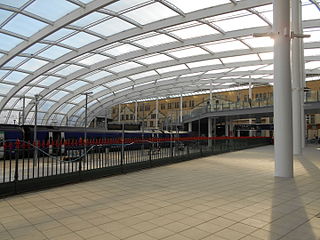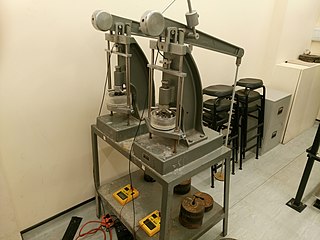
British Standards (BS) are the standards produced by the BSI Group which is incorporated under a royal charter and which is formally designated as the national standards body (NSB) for the UK. The BSI Group produces British Standards under the authority of the charter, which lays down as one of the BSI's objectives to:
Set up standards of quality for goods and services, and prepare and promote the general adoption of British Standards and schedules in connection therewith and from time to time to revise, alter and amend such standards and schedules as experience and circumstances require.

Rebar, known when massed as reinforcing steel or steel reinforcement, is a tension device added to concrete to form reinforced concrete and reinforced masonry structures to strengthen and aid the concrete under tension. Concrete is strong under compression, but has low tensile strength. Rebar usually consists of steel bars which significantly increase the tensile strength of the structure. Rebar surfaces feature a continuous series of ribs, lugs or indentations to promote a better bond with the concrete and reduce the risk of slippage.
BS 7799 was a British standard "Code of Practice for Information Security Management", first published as such by the British Standards Institution (BSI) in February 1995. Read about the origins of BS 7799 here.
BS 8110 is a withdrawn British Standard for the design and construction of reinforced and prestressed concrete structures. It is based on limit state design principles. Although used for most civil engineering and building structures, bridges and water-retaining structures are covered by separate standards. The relevant committee of the British Standards Institute considers that there is no need to support BS 8110.

The Eurocodes are the ten European standards specifying how structural design should be conducted within the European Union (EU). These were developed by the European Committee for Standardization upon the request of the European Commission.

Structural steel is a category of steel used for making construction materials in a variety of shapes. Many structural steel shapes take the form of an elongated beam having a profile of a specific cross section. Structural steel shapes, sizes, chemical composition, mechanical properties such as strengths, storage practices, etc., are regulated by standards in most industrialized countries.
ISO 11170:2003 is an international standard which defines a sequence of tests for verifying filter elements. It can be used to check their hydraulic, mechanical and separation characteristics. ISO 11170 is not intended to qualify a filter for a particular duty or replicate conditions of service. This can only be done by a specific test protocol developed for the purpose, including actual conditions of use. The procedure in ISO 11170 is applicable to individual fluids, or types of fluid having similar chemistry.

The British Standards Institution (BSI) is the national standards body of the United Kingdom. BSI produces technical standards on a wide range of products and services and also supplies certification and standards-related services to businesses.
In solid mechanics and structural engineering, section modulus is a geometric property of a given cross-section used in the design of beams or flexural members. Other geometric properties used in design include: area for tension and shear, radius of gyration for compression, and second moment of area and polar second moment of area for stiffness. Any relationship between these properties is highly dependent on the shape in question. There are two types of section modulus, elastic and plastic:

Sprinkler fitting is a skilled trade that consists of assembling, installing, testing, repairing, inspecting, and certifying automatic fire suppression systems and their associated piping in commercial, industrial and residential buildings.
The EN 10034 "Structural steel I and H sections. Tolerances on shape and dimensions" is a European Standard. The standard is developed by the technical committee ECISS/TC 103 - Structural steels other than reinforcements. The standard specifies tolerances on dimensions and mass of I and H structural steel beams.
Tri-rated cable is a high temperature, flame retardant electrical wire designed for use inside electrical equipment.
PAS 2060 is a specification detailing how to demonstrate carbon neutrality produced and published by the British Standards Institution.

An oedometer test is a kind of geotechnical investigation performed in geotechnical engineering that measures a soil's consolidation properties. Oedometer tests are performed by applying different loads to a soil sample and measuring the deformation response. The results from these tests are used to predict how a soil in the field will deform in response to a change in effective stress.

BCSA Ltd is a trade association for the structural steel industry in the UK and Ireland. It lobbies on behalf of its members, and provides them with education and technical services.
ISO 20121 is a voluntary international standard for sustainable event management, created by the International Organization for Standardization. The standard aims to help organizations improve sustainability throughout the entire event management cycle.
ISO/IEC 27001 is an international standard to manage information security. The standard was originally published jointly by the International Organization for Standardization (ISO) and the International Electrotechnical Commission (IEC) in 2005, revised in 2013, and again most recently in 2022. There are also numerous recognized national variants of the standard. It details requirements for establishing, implementing, maintaining and continually improving an information security management system (ISMS) – the aim of which is to help organizations make the information assets they hold more secure. Organizations that meet the standard's requirements can choose to be certified by an accredited certification body following successful completion of an audit. A SWOT analysis of the ISO/IEC 27001 certification process was conducted in 2020.
BS 7910, guide to methods for assessing the acceptability of flaws in metallic structures, is a British Standard code of practice for the assessment of flaws using fracture mechanics principles. The technique is also referred to as an engineering critical assessment (ECA) or damage tolerance, and is complementary to other methods of weld quality assurance.
BS 8599 is a technical standard published by the British Standards Institution listing recommended contents of first aid kits for workplaces and motor vehicles.







